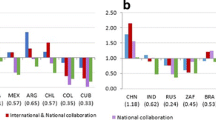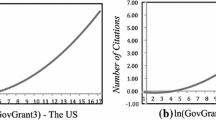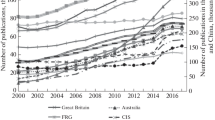Abstract
This study deals primarily with the effect of certain European Framework Programmes on EU-27 member states’ publication output in nanotechnology, with a focus on their scientific collaboration over the last ten years. The study was conducted at three levels (category, journal and publication). The aim was to verify whether the newly launched category is sufficiently complete, as well as to identify the most prominent journals and compare the EU-27 member states’ output to world production. Snapshots of European networking are also provided for three key dates (2001, 2006 and 2011) to ascertain the positions of emerging and central countries and analyse their variations over time. The results confirm the speedy development in the field and the importance of the EU-27s world role. They corroborate the close correlation between funding and increased output and the intensification of collaboration among member states. Finally, the information contained in the “Funding Agency” field in the Web of Science database was also compiled, with a view to substantiating the validity of the estimated impact of EU-funding programmes on member states’ scientific output.









Similar content being viewed by others
Notes
http://cordis.europa.eu/fp7/cooperation/home_en.html. Last review: 20 Feb 2013.
http://europa.eu/about-eu/countries/index_en.htm. Last review: 20 Feb 2013.
In information retrieval, precision is the fraction of retrieved items that are relevant, while recall is the fraction of relevant items that are retrieved. Both are therefore based measure of relevance http://en.wikipedia.org/wiki/Precision_and_recall. Last review: 20 Feb 2013.
Following an iterative process to identify relevant identifiers has also been tested, however, this approach turned out to be very cumbersome and did not improve the quality in comparison to samples 2 and 3.
Since 2012, WoS enables the search of all the publications related to a WoS subject category (WS =). Otherwise, the search must be done for all journal titles assigned to the corresponding WoS Category.
(1) http://www.theiet.org/resources/inspec/about/, (2) http://www.nlm.nih.gov/pubs/factsheets/mesh.html, (3) http://eurovoc.europa.eu/drupal/, (4) http://bioportal.bioontology.org/ontologies/47638?p=terms and (5) http://www.wipo.int/classifications/ipc/en/. Last review 26 Feb 2013.
The resulting search string is: TS = (“nanotechn* or nano-techn*”) OR TS = (nanobiotechnolog* OR nano-biotechnolog* OR nanocontact* OR nano-contact* OR nanostructure* OR nano-estructure* OR nanoelectric* OR nano-electric* OR (nanoelectromechanical devide* OR nanosensor* OR nanofluid*) OR nanoelectronic* OR nano-electronic* OR nanofabrication* OR nano-fabrication* OR nanolithograph* OR nano-lithograph* OR nanomagnetic* OR nano-magnetic* OR nanomagnetism* OR nano-magnetism* OR nanomechanic* OR nano-mechanic* OR nanoidentation* OR nano-identation* OR nanomedicine OR nano-medicine OR nanooptic* OR nano-optic* OR nanopatterning OR nano-patterning OR nanophotonic* OR nano-photonic* OR nanopositioning OR nano-positioning).
TS = (atomic force* microscop* OR bio-inspired material* OR bioinspired material OR fullerene device* OR integrated circuit* technolog* OR lithograph* OR microchemistr* OR microchip analytical procedure* OR microfabrication* OR micromechanical device* OR miniaturization* OR nanobridge* OR nano-bridge* OR nanocomposite* OR nano-composite* OR nanofiber* OR nano-fiber* OR nanofiltration* OR nano-filtration* OR nanomaterial* OR nano-material* OR nanoparticle* OR nano-particle* OR nanopore* OR nano-pore* OR nanotube devide* OR nano-tube devide* OR nanoscience OR nano-science OR nanotube* OR nano-tube* OR nanowire* OR nano-wire* OR optical trap OR optical tweezer* OR scanning tunneling microscop* OR single electron transistor* OR superconducting OR VLSI).
Based on data collected from SCImago Journal & Country Rank (SJCR). http://www.scimagojr.com/. Last review 18 Feb 2013.
The four UK countries (England, Northern Ireland, Scotland and Wales) were considered separately in this analysis.
Deutsche Forschungsgemeinschaft (DFG, http://www.dfg.de. Last review 15 Feb 2013).
References
Börner, K., Sanyal, S., & Vespignani, A. (2007). Network science. Annual Review of Information Science and Technology, 41, 537–607.
Brechi, S., & Malerba, F. (2011). Assessing the scientific and technological output of EU Framework Programmes: Evidence from de FP& in the ICT field. Scientometrics, 88(1), 239–257.
Chen, H., & Roco, M.C. (2009). Topological analysis of patent citation networks: Nanotechnology at Uspto, 1976–2004. In Mapping nanotechnology innovations and knowledge: Global and longitudinal patent and literature analysis (Vol. 20, pp. 143–167). Berlin: Springer.
Delanghe, H., Sloan, B., & Muldur, U. (2011). European research policy and bibliometric indicators, 1990–2005. Scientometrics, 87(2), 389–398.
European Policy Evaluation Consortium (EPEC). (2011). Understanding the long term impact of the Framework Programme: Final report. DG BUDG No BUDG06/PO/01/LOT no.3. Retrieved February 14, 2013, from http://ec.europa.eu/research/evaluations/pdf/archive/other_reports_studies_and_documents/long_term_impact_of_the_fp.pdf.
Glaenzel, W. (2012). The role of core documents in bibliometric network analysis and their relation with h-type indices. Scientometrics, 93(1), 113–123. doi:10.1007/s11192-012-0639-3.
Glaenzel, W., Janssens, F., & Thijs, B. (2007). A comparative analysis of publication activity and citation impact based on the core literature in bioinformatics. Scientometrics, 79(1), 109–129. doi:10.1007/s11192-009-0407-1.
Gorraiz, J., Gumpenberger, C., Schloegl, C., & Wieland, M. (2012). On the temporal stability of Garfield’s impact factor and its suitability to identify hot papers, 17th International Conference on Science and Technology Indicators (STI), 5–8 September, 2012 in Montreal, Quebec, Canada.
Hullmann, A. (2007). Measuring and assessing the development of nanotechnology. Scientometrics, 70(3), 739–758.
Kamada, T., & Kawai, S. (1989). An algorithm for drawing general undirected graphs. Information Processing Letters, 31(1), 7–15.
Leydesdorff, L. (2008). The delineation of nanoscience and nanotechnology in terms of journals and patents: A most recent update. Scientometrics, 76(1), 159–167.
Leydesdorff, L., & Zhou, P. (2007). Nanotechnology as a field of science: Its delineation in terms of journals and patents. Scientometrics, 70(3), 693–713.
Luukkonen, T. (1998). The difficulties in assessing the impact of EU framework programmes. Research Policy, 27, 599–610.
Luukkonen, T., Tijssen, R. J. W., Persson, O., & Sivertsen, G. (1993). The measurement of international scientific collaboration. Scientometrics, 28(1), 15–36.
Meyer, M., Persson, O., & Power, Y. (2001). Mapping excellence in nanotechnologies: Preparatory study (Nanotechnology expert group and Eurotech data). European Comission. Retrieved February 18, 2013, from http://ec.europa.eu/research/era/pdf/nanoexpertgroupreport.pdf.
Newman, M. E. (2008). The mathematics of networks. The New Palgrave Encyclopedia of Economics. Retrieved February 12, 2013, from http://citeseerx.ist.psu.edu/viewdoc/download?doi=10.1.1.131.8175&rep=rep1&type=pdf.
Nooy, W., Mrvar, A., & Batagelj, V. (2004). Exploratory social network analysis with Pajek (Structural Analysis in the Social Sciences, 27). New York: Cambridge University Press.
Rueda, G., Gerdsri, P., & Kocaoglu, D. F. (2007). Bibliometrics and social network analysis of the nanotechnology field. PICMET 2007 proceedings, (pp. 2905–2911).
Schummer, J. (2007). The global institutionalization of nanotechnology research: A bibliometric approach to the assessment of science policy. Scientometrics, 70(3), 669–692.
Scott, J. (2000). Social network analysis: A handbook (2nd ed.). Los Angeles: Sage.
Tang, L., & Shapira, P. (2011). China–US scientific collaboration in nanotechnology: Patterns and dynamics. Scientometrics, 88(1), 1–16.
Van Leeuwen, T. N., & Tijssen, R. J. W. (2007). Strength and weakness of national science systems. A bibliometric analysis through cooperation patterns. Scientometrics, 79(2), 389–408.
Zitt, M., & Bassecoulard, E. (2006). Delineating complex scientific fields by an hybrid lexical-citation method: An application to nanosciences. Information Processing and Management, 42(6), 1513–1531. doi:10.1016/j.ipm.2006.03.016.
Author information
Authors and Affiliations
Corresponding author
Rights and permissions
About this article
Cite this article
Ovalle-Perandones, MA., Gorraiz, J., Wieland, M. et al. The influence of European Framework Programmes on scientific collaboration in nanotechnology. Scientometrics 97, 59–74 (2013). https://doi.org/10.1007/s11192-013-1028-2
Received:
Published:
Issue Date:
DOI: https://doi.org/10.1007/s11192-013-1028-2




